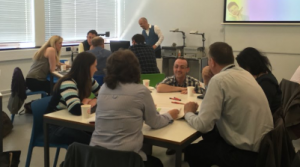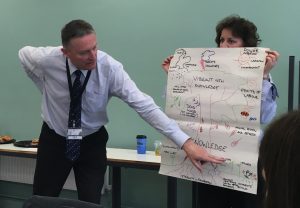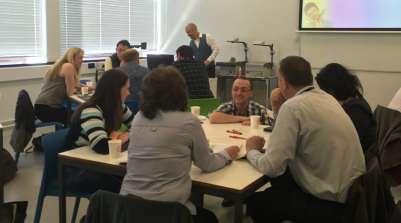In May Chris Thomson and I had the pleasure of working with staff at Queens University Belfast. We delivered a series of worskshops to explore what the student of the future might look like, how we can support them effectively and what we need to consider when designing for the digital curriculum.

The workshops built on much of the previous work Jisc has carried out in this area, but the activities themselves were tailored to fit Queen’s particular context. Having said that, many of the activities we did are equally relevant to other universities and colleges too.
Here’s a snapshot of our experiences.
What does the student of the future look like?
Future-gazing trends in education and technology is challenging to do, but it’s also a lot of fun! It’s fun because it allows your imagination and creativity free reign to explore the unknown.
Articulating what our students of the future may look like is also a worthwhile activity. It helps at the curriculum design stage when building in meaningful digital aspects that nurture students and prepare them for when they leave their course.
We used Jisc’s learner profile as a starting point to help inform our thinking, which lead us on to a great activity created by Helen Beetham. This involved posing a hypothetical situation of a student from the future contacting their former lecturer, due to a glitch in the space-time continuum. Yes, of course it couldn’t really happen (except perhaps in episodes of Star Trek), but it does get staff thinking about what the future holds for learners.
We did this on the day by making use of discussion forums on the university’s Virtual Learning Environment (VLE). This was largely because we wanted to use the systems that staff themselves would be using with their own students but it also allowed for fruitful discussions about how we build in collaboration activities for students too.
One of the key points I took away from this was the need to scaffold digital activities appropriately beforehand, especially ones that involve online collaboration and discussion. Students need to be clear on what is expected from them and understand how they will be supported if they need help. It is perhaps all too easy to assume that students are familiar with online networking and that they’re already proficient with it. This may be true in some cases, but not all. What if, for example, the student is from outside of the UK and English isn’t their first language? Or if they have previously experienced trolling online due to their race, religion or sexual orientation?
We also did a fun activity where we got staff to draw their student of the future. This provided a visual way for staff to articulate how they perceive their students and produced some very impressive drawings on the fly!

Interestingly, many of the key themes that arose in the drawings were things like barriers to engagement, online language, digital values, balance in life and work/study, stability and sustainability for our students, as well as the threats and challenges.

This activity challenged many of the assumptions we sometimes have of our students and emphasised the need to have those conversations with our students. Jisc has done a lot of work in this area and we are thrilled to announce that the Digital Experience Insights service (which includes the Student Digital Experience Tracker) will become available later this year which helps with this particular challenge.
Discovering your own digital capabilities
Meeting student expectation when it comes to designing for the digital curriculum also requires an understanding of your own digital capabilities.
Queens university, along with many other universities and colleges across the UK, are currently piloting Jisc’s discovery tool. This tool encourages individuals to reflect on and develop their own digital capabilities. It also provides a summary of their self-assessment in response to nuanced question prompts as well as suggestions for further development with links to relevant, interactive resources.
After staff had run through the tool we asked them to plot their indiividual digital capabilities using a ‘tension pairing’ activity. This involved indiividuals thinking more deeply about which capabilities they need to develop for specific courses and how easy or difficult it would be for them to master.

I really like this activity because it provides individuals with a sense of perspective. The whole area of digital capability can be a little overwhelming – there are so many tools out there and so many different approaches one could take.
Mapping your digital capabilities in this way helps you to prioritise and identify the quick wins as well as the longer term goals to strive towards.
How do we deliver a digital curriculum?
After having reflected on what our students may look like we moved on to the more practical aspects of how we meet and support the needs of our students.
Jisc has produced a number of resources to help teaching staff think about where the technology might fit in a particular course or module which we used on the day. These can all be seen through the lens of Jisc’s digital capability framework, which includes the six elements model.
Incidentally, Jisc is running a public Curriculum Confidence workshop in Manchester on 10th October. There’s more information on the Jisc Training web pages.
We rounded the workshop off by spending an hour or so looking at the ABC Curriculum Design resources created by Clive Young and Nataša Perović at UCL. These are openly available and we highly recommend them to anyone working on module design. They are a great way of getting teaching teams together, mapping out the balance of different learning types used during a module and thinking constructively about which elements to blend.
We found that these resources worked well when complemented by the Jisc Curriculum Confidence materials as they can give different perspectives on the same module.
We wish the staff at Queen’s all the very best.

